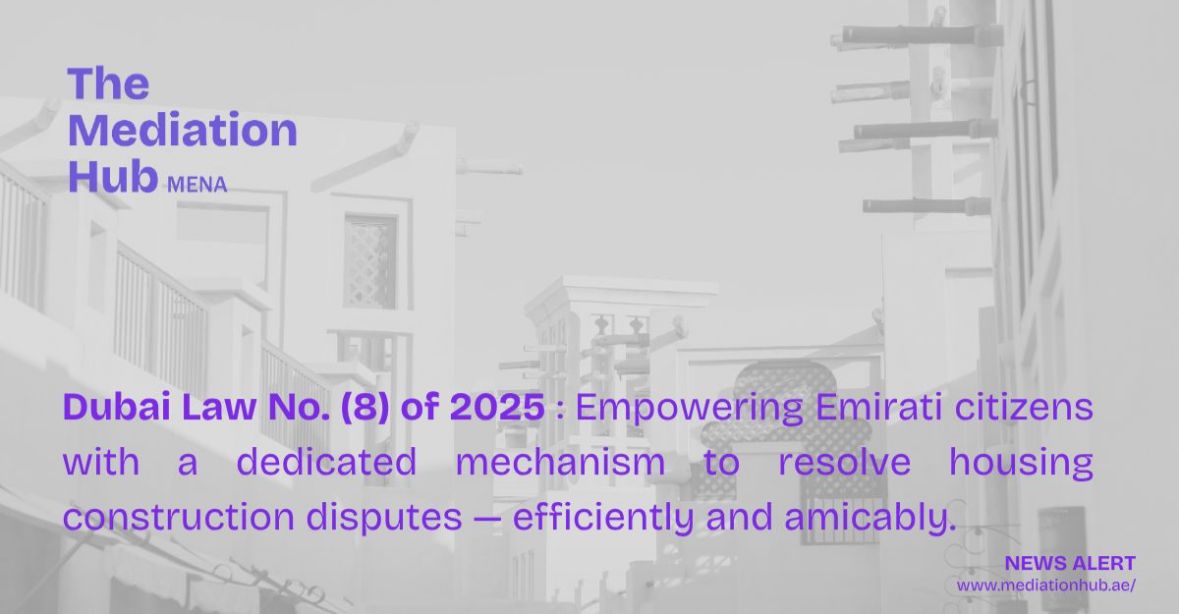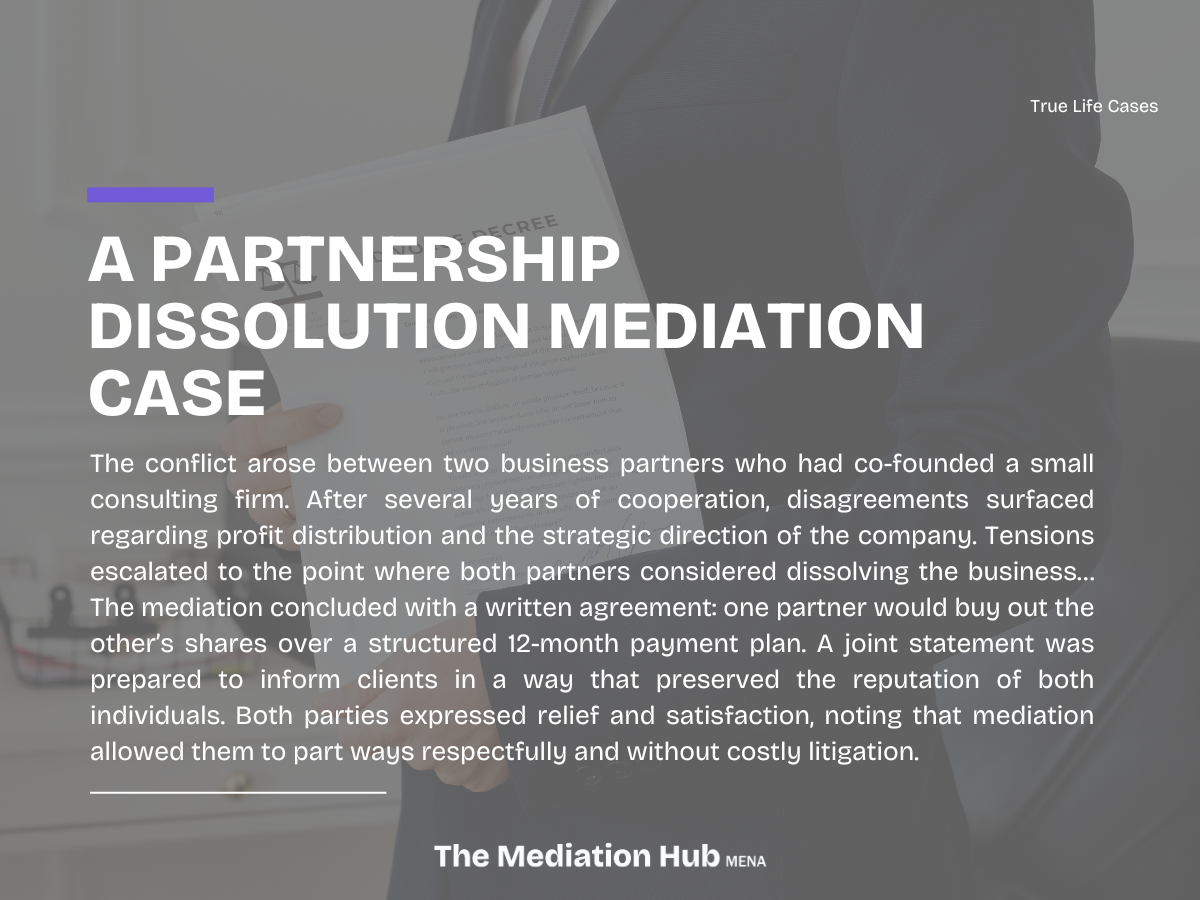الموارد
بوابتك إلى ثروة من المعرفة والرؤى والأدوات في مجال حل النزاعات البديلة. استكشف مواردنا المنسقة بعناية والمصممة لتمكين وإعلام الأفراد والمهنيين والمنظمات المشاركة في الوساطة وحل النزاعات.
أحدث الأخبار
عرض آخر الأخبار والتطورات والمستجدات في مجال الوساطة من منطقة الشرق الأوسط وشمال إفريقيا.

The Dubai International Financial Centre (DIFC) Courts has taken a major step in expanding access to justice with the launch of a new Mediation Services, providing businesses and residents in the UAE with cost-effective, flexible dispute resolution options.
This initiative follows the issuance of Dubai Law No. (2) of 2025 by HH Sheikh Mohammed bin Rashid Al Maktoum and a resolution by HH Sheikh Maktoum bin Mohammed bin Rashid Al Maktoum, which formally authorized the establishment of the Mediation Service within the DIFC Courts.
Mediation Service
A dedicated service for alternative dispute resolution, enabling parties to select registered mediators, agree fees and terms upfront, and conduct proceedings either in person at DIFC or virtually through the AI-enabled Court Management System (CMS).
Chief Justice Wayne Martin emphasized that the service “broadens access to justice and provides greater flexibility for businesses and individuals seeking efficient, cost-effective solutions.”
This development marks a significant milestone in advancing Dubai’s vision for a transparent, efficient, and future-ready legal system — strengthening its position as a global hub for trade, investment, and dispute resolution.

Dubai Law No.(8) of 2025
On 8 July 2025, His Highness Sheikh Mohammed bin Rashid Al Maktoum issued Law No. (8) of 2025, establishing a dedicated legal mechanism to resolve disputes arising from the execution of home construction contracts for Emirati citizens in Dubai.
The law introduces a structured, alternative dispute resolution system aimed at preserving contractual relationships, ensuring timely project delivery, and minimizing reliance on formal litigation.
Key Features of the Law:
- Establishes a specialized branch under the Centre for Amicable Settlement of Disputes, with jurisdiction over housing construction disputes not exceeding AED 10 million.
- Applies to disputes related to payment delays, variations in materials or design, construction defects, delays in project timelines, and contractual breaches by contractors or engineers.
- Requires disputes to first undergo a mediation process within 20 days, extendable once by mutual agreement.
If mediation fails, the dispute is referred to a dedicated committee comprising a judge and two specialists, which must issue a decision within 30 days, also extendable once.
- Committee decisions carry the force of an executive instrument and may be appealed before the Court of First Instance within 30 days of issuance.
- Legal limitation periods are suspended during the resolution process, and the registration fee for disputes is capped at AED 250.
The law comes into effect on 1 January 2026, marking a significant step toward institutionalizing alternative dispute resolution for Emirati citizen in the construction sector and aligns with Dubai’s broader commitment to accessible, efficient, and citizen-focused legal services.

Dubai's Conciliation Law Transformed: Scope, Structure & Settlement Power Under Law 9 of 2025
Key Amendments to the Dubai Conciliation Law: What You Need to Know
Dubai Law No. 9 of 2025 has introduced significant changes to thedispute resolution landscape in Dubai, amending the previous Conciliation Law (DubaiLaw No. 18 of 2021 regulating conciliation activities the Emirate of Dubai). Here are the highlights:
• Expanded Scope for Conciliation: Conciliation is now permitted inpersonal status disputes (with limited exceptions), with the FamilyReconciliation and Guidance Committee playing a central role.
• Streamlined Procedures: All disputes must now be processed through the Courts’ electronic portal and supervised by a competent judge, ensuring greater oversight and efficiency.
• Empowered Government Agencies: The Center for Amicable Settlementof Dispute can delegate conciliation to government agencies or authorizedentities, who can now handle disputes and certify settlement agreements.
• Enforceability of Settlements: Settlement agreements certified by authorized conciliators are now directly enforceable once endorsed, with clear procedures for challenging or refusing certification.
• Mandatory Conciliation: Courts are prohibited from registeringclaims subject to mandatory conciliation unless first presented to the appropriateconciliation body, ensuring disputes follow the correct process.
• Formalities and Language: Settlement agreements must bebilingual, with Arabic prevailing, and must meet new certification requirementsto be enforceable.
These amendments enhance legal certainty, speed up dispute resolution, and reinforce the enforceability of settlements in Dubai. Businesses and individuals should ensure compliance with the new procedures to avoid risks of unenforceable agreements or procedural delays.

Help Shape the Future of Dispute Resolution in the MENA Region
The Mediation Hub MENA, a DIFC-based non-profit organization, is conducting a regional survey to assess industry readiness for adopting mediation as a strategic tool for dispute avoidance and resolution.
With increasing recognition through recent UAE legislation and alignment with ESG principles, mediation is becoming a key element in modern dispute management.
Whether you have experience with mediation or are simply exploring it, your input is vital.
Take the survey and contribute to building a more collaborative, effective dispute resolution culture across the region.
Link: https://docs.google.com/forms/d/e/1FAIpQLSfWqnN8jcq5Wsp39oY0p-X8Ly_zvv7m4Oc_5kQOlV3L2imX1g/viewform

حلقة نقاش خلال RIDW 2024 - الوساطة كأداة فعالة لمعالجة نزاعات الاستثمار في المملكة العربية السعودية والمنطقة الأوسع
كجزء من أسبوع الرياض للمنازعات الدولية، عُقدت حلقة نقاش حول أدوات حل النزاعات في منازعات الاستثمار في 7 مارس 2024 في كراون بلازا الرياض.
وتألفت اللجنة من عدد متنوع من الخبراء الدوليين البارزين والمتحمسين للوساطة: برايان كلارك، وفارس ألغارني، وتات ليم، وشريف النجاهي، وصوفي تكمالادزي، وأحمد حمدان، وإيليني شارالامبيدو.
وأبرزت حلقة النقاش كيف يمكن للوساطة أن تكون أداة فعالة لمعالجة النزاعات الاستثمارية المختلفة وخاصة في المملكة العربية السعودية والعالم العربي بشكل عام.
كانت أسئلة الجمهور وتعليقاته رائعة.
وقد تكرمت وزارة الاستثمار السعودية برعاية اللجنة.
أحدث المنشورات
عرض موضوعات في الوقت المناسب في الوساطة من خبراء رائدين في الصناعة.

Constructionprojects are inherently complex and structured, often involving diverseparties, tight timelines, and substantial budgets. In today’s high-stakes construction projects, disputes are inevitable; however, how they are handled can determine the success or failure of multi-million-dollar ventures. To manageinevitable conflicts, the FIDIC (Fédération Internationale des Ingénieurs-Conseils) agreements have evolved dramatically, from litigation towards collaborative processes like adjudication and finally toward mediation. This shift reflects a growing emphasis on resolving disputes efficiently, maintaining project momentum, and preserving long-term relationships. Below, we trace this evolution, presenting Sub-Clause 21 in its entirety, before demonstrating how mediation naturally integrates into the FIDIC framework.
To understand how mediation emerged, it is essential to revisit the earlymechanisms of disputes management. Historically, under the 1999 FIDIC editions, a Dispute Adjudication Board (DAB) was introduced to deliver fast, interimdecisions during project execution, reducing obstruction and reliance on costlyarbitration. These boards often encouraged settlement before formal rulings, introducing a conciliation-like element informally into proceedings.
By2017, the Dispute Adjudication Board became a Dispute Avoidance/Adjudication Board (DAAB). The DAAB role was explicitly expanded to include helping parties avoid disputes. This shift signified FIDIC’s intention to proactively manage differences through dialogue, creating space for structured collaboration—like mediation—before matters escalate. The 2017 amendments introduced, through the Clause21, a structured reference for dispute resolution procedures, creating a clear pathway from notice to adjudication, “amicable settlement”, and ultimatelyarbitration.
The text of Sub-Clause 21.3 and Sub-Clause 21.4 (summarized for clarity) reads as follows:
Sub-Clause21.3 [Dispute Avoidance/Adjudication Board]: The DAAB shall be in place from the beginning of the contract. Its role is not limited to adjudication but alsoincludes dispute avoidance. The DAAB may invite the Parties to attempt toresolve issues amicably before rendering a decision.
Sub-Clause21.4 [Amicable Settlement]: If a Party is dissatisfied with the DAAB’s decision, it may issue a Notice ofDissatisfaction. In such case, the Parties shall attempt to settle the disputeamicably before referring it to arbitration.
In summary, Clause 21 of the FIDIC 2017 Red Book sets out a comprehensive Ulti-tiered approach to dispute resolution. It begins with the notification of claims, followed by the proactive role of the Dispute Avoidance/Adjudication Board (DAAB) to either prevent disputes from arising or to adjudicate them swiftly when they do. If disagreements persist, the clause insists on a phase of amicable settlement before moving forward to arbitration. This layered structure reflects FIDIC’s philosophy of balancing efficiency with fairness, ensuring that disputes are addressed early and constructively.
Here lies the missing link: while Sub-Clause 21.3 introduces the DAAB’s facilitative and preventive role, Sub-Clause 21.4 institutionalizes the obligation for the parties to attempt “amicable settlement.” Although FIDIC does not explicitly name mediation, this structured and confidential process where a neutral third party facilitates dialogue, and negotiation serves as the perfect entry point for resolving disputes. This amicable settlement phase essentially acts as a mandatory cooling-off period, requiring parties to attempt resolution before escalation.
By agreeing to appoint a neutral mediator within the amicable settlement window (commonly 28 to 56 days), parties can structure the process, fulfill their obligation and maximize the chance of resolving the dispute without escalation. In this sense, Sub-Clause 21.4 provides legal grounding to mediation within the FIDIC hierarchy, turning what could otherwise be a passive obligation into an active and results-oriented procedure.
When carefully examined, Sub-Clause 21.3 represents more than a procedural step; it is a subtle but deliberate gateway to consensual dispute resolution. The DAAB role is to issue a decision that is binding but not final, which means parties must comply immediately, yet they retain the right to challenge the outcome. Thiscreates an intermediate space between compliance and final resolution, a spacethat is uniquely suited for mediation.
Together, Sub-Clause 21.3 and 21.4 form a continuum: the DAAB first encourages resolution through dialogue, and if its decision is contested, the “amicable settlement” obligation seamlessly opens the door to mediation as the natural next step.
In practice, this structured approach often prevents disputes from escalating unnecessarily. A party dissatisfied with a DAAB decision may hesitate to move directly to arbitration because of its costs, length, and adversarial nature. In this context, mediation emerges as a pragmatic alternative, allowing parties to reassess their positions, preserve confidentiality, and negotiate a mutually beneficial solution without jeopardizing the project timeline.
For example, consider a dispute where a contractor claims additional costs due to unforeseen ground conditions. The DAAB might issue a binding but not final decision awarding part of the claim. The employer, dissatisfied, issues a Notice of Dissatisfaction under Sub-Clause 21.4. Rather than rushing to arbitration, both parties agree to mediation. In just few sessions, they reach a creative settlement covering payment terms and project adjustments, preserving the project’s timeline and saving millions in arbitration costs. This example illustrates how mediation gives real substance to the “amicable settlement” requirement and is increasingly recognized as best practice in large-scale international projects.
This is particularly relevant in international construction projects, where disputes often revolve around variations, delays, or unforeseen site conditions. Instead of litigating technical disagreements through formal channels, parties can move toward a facilitated dialogue with the DAAB’s encouragement. Many practitioners now view this sub-clause as the hinge that operationalizes mediation within the FIDIC framework, making it an essential feature of modern project dispute management and not an optional accessory.
The insertion of mediation in the FIDIC dispute resolution ladder is not merelysymbolic; it produces tangible value for all stakeholders. First and foremost,mediation helps preserve commercial and contractual relationships, restorestrust and fosters cooperative problem-solving, which is indispensable whencontractors and employers must continue working together until projectcompletion.
Mediationalso significantly reduces costs and delays compared to arbitration orlitigation. By resolving disagreements in weeks rather than years, partiesavoid project stagnation and financial drain. This efficiency is fully alignedwith FIDIC’s philosophy of ensuring that disputes do not derail the works.
Moreover, mediation enhances the legitimacy of outcomes. Unlike arbitral awards, whichimpose a solution, mediated agreements are co-created by the partiesthemselves. This voluntary character increases compliance rates and reduces therisk of future disputes over the same issues. Within the FIDIC structure,mediation complement the DAAB’s preventive and adjudicative roles rather thancompeting with them.
Ultimately, by embracing mediation at the stage opened by Sub-Clause 21.3 and solidified by Sub-Clause 21.4, FIDIC users are not simply following a procedure; they are adopting a culture of proactive dispute management. This represents a decisive step toward a more collaborative and sustainable future in the global construction industry.
The evolution from litigation and arbitration to negotiation, adjudication, and ultimately mediation reflects a broader shift in the construction industry: one toward collaboration, efficiency, and dispute prevention. Clause 21, particularly through the interplay of Sub-Clauses 21.3 and 21.4, serves as the pivotal mechanism enabling this transformation. By understanding and leveraging the DAAB and the mediation pathway, project stakeholders can not only resolve disputes effectively while fostering long-term relationships and project success. FIDIC’s approach demonstrates that the future of dispute resolution lies not in adversarial battles, but in structured, cooperative, and creative problem-solving. In this way, FIDIC not only manages disputes, but it also redefines them. The journey from dispute boards to mediation shows that in construction, collaboration is no longer just a choice; it is the new standard for success.

The Art of Questioning in Mediation
One of the most challenging yet crucial tools in mediation is the questioning technique. I like to refer to it as the art of questioning because it truly reflects the skill and wisdom of a mediator. In the mediation process, the ability to ask the right questions is not just a skill but an art form that can significantly influence the outcome. Mediators play a vital role in guiding conflicting parties toward resolution, and effective questioning is at the heart of this process.
Open questions, which invite expansive responses, are instrumental in uncovering underlying interests and feelings. For instance, asking, “What concerns do you have about this situation?” encourages parties to express their thoughts and emotions freely. This exploration fosters understanding and empathy, both of which are essential components in resolving disputes.
Conversely, closed questions serve a different purpose. They help clarify facts or confirm specific details. A question like, “Did you agree on the terms of the contract?” quickly establishes a focal point for discussion. Both types of questions are essential, as they enable the mediator to navigate the dialogue effectively.
Additionally, the techniques of “chunking up” and “chunking in” can enhance questioning strategies. Chunking up involves asking broader questions to help parties see the bigger picture, while chunking in focuses on specific details to clarify misunderstandings. Together, these techniques equip mediators to facilitate meaningful conversations that lead to genuine resolutions.
In summary, mastering the art of questioning empowers mediators to create a safe space for dialogue, allowing conflicting parties to move from confrontation to cooperation. Embracing this skill not only enhances the mediation process but also cultivates a culture of understanding and collaboration.

From contract clash to constructive agreement
A dispute emerged between a government body and a private education technology provider over the interpretation of a Call-Off Contract for a national pool of teachers. The government believed its termination notice ended the agreement with no further financial obligations, while the supplier insisted that six months’ notice had to be given before the next renewal date, entitling it to a full year’s fees. What began as a disagreement over contract terms quickly grew into a conflict that threatened litigation, unpaid fees, reputational harm, and a breakdown in cooperation.
To resolve this impasse, the parties agreed to mediation. Conducted online over a single day, both sides were represented by legal and commercial teams. Wolf von Kumberg, the mediator, guided the process with a facilitative and evaluative style. A joint session clarified the issues, followed by private caucuses where shuttle diplomacy allowed him to test proposals, reframe positions, and redirect the focus from legal arguments to business solutions.
Key tools played a decisive role. Issue mapping broke the dispute into manageable topics — from termination terms and payment to reputation and future relationships — revealing areas of overlap. Through option development, the parties explored creative settlement packages with different payment structures and contract scenarios. Reframing helped shift the narrative away from “who was right on the contract” toward “how to preserve value and manage risk going forward.” Positioning any payment as an act of goodwill, rather than an admission of liability, also made it possible for both sides to save face.
By the end of the day, the dispute transformed into a constructive agreement. The parties decided to terminate the existing contract from the date of the government’s notice, with a lump-sum payment equivalent to several months of licence fees. At the same time, they signed a new agreement covering a smaller number of authorities, with flexibility to expand later. A clear exit plan and data governance measures ensured compliance with GDPR and a smooth transition. Importantly, they issued a joint public statement framing the outcome as a policy shift, not a platform failure, protecting reputations on both sides.
The result was a win-win: the supplier secured guaranteed payment and preserved a valuable relationship, while the government capped its financial exposure, avoided litigation risk, and ensured continuity of service. This case demonstrates how structured negotiation, option-building, and skilled mediation can turn a contentious contractual dispute into a pragmatic, forward-looking settlement.

Turning a Contract Crisis into Collaboration
A major dispute arose between a South Asian manufacturer of home appliances and a Middle Eastern distributor. The two companies had signed a contract worth USD 13.4 million for the shipment of 100,000 units. After only 30% of the order was completed, the relationship deteriorated. The distributor raised concerns about delays in the first shipments and claimed that certain units showed quality inconsistencies. On the other hand, the manufacturer accused the distributor of withholding the second installment of payment, which was clearly outlined in the contract. The disagreement escalated quickly, with both sides threatening to terminate the contract and pursue legal action, putting years of cooperation and trust at serious risk.
How the Mediation Process Was Conducted I was invited to intervene as a mediator to help prevent the collapse of the deal. My first step was to conduct separate intake meetings with both parties, during which I explained the principles of confidentiality, neutrality, and the process we would follow. Each party submitted a written statement summarizing their grievances. These initial discussions revealed the true underlying interests: the distributor was deeply concerned about its reputation in the Middle Eastern retail market if it delivered products with quality issues, while the manufacturer’s priority was ensuring steady cash flow to sustain production and avoid factory disruptions.
When the first joint session began, the distributor expressed frustration about the shipment delays and the risk of damaged credibility with its retail clients. The manufacturer responded strongly, highlighting the significant costs already incurred and the financial pressure from the withheld payment. Both sides initially used accusatory language such as unreliable and bad faith. My role was to reframe these terms into neutral and constructive concerns, translating unreliable partner into need for reliability, and bad faith into need for assurance of commitment. This shift in language helped lower tensions and allowed us to set a clear agenda around three key issues: the release of pending payments, the quality assurance process, and the timeline for completing the remaining shipments.
In the following caucus sessions, I met privately with each party. Using BATNA and WATNA analysis, I guided them through the consequences of litigation compared with negotiated settlement. Both sides realized that going to court would not only drain resources but could also jeopardize their positions in their respective markets. With this understanding, they became more open to negotiation.
During the extended joint negotiation, I introduced tools to facilitate clarity and constructive problem-solving. We developed a shared timeline map that illustrated production, delivery dates, inspection reports, and payment obligations. This visual removed much of the ambiguity that had fueled mistrust. We also used an option-generation matrix to explore different settlement structures, such as staged payments tied to third-party inspection results and revised shipment schedules. At critical moments, I employed structured silence, giving the parties space to process proposals without reacting defensively. This encouraged deeper reflection and made them more willing to explore compromise.
Tools and Strategies That Proved Helpful:
● Reframing accusatory language into constructive needs.
● BATNA and WATNA analysis to highlight the risks of litigation versus settlement.
● Shared timeline maps to visualize obligations and deadlines.
● Option-generation matrix for structured solutions.
● Strategic use of silence to allow reflection.
Outcome and Settlement Ultimately, the mediation produced a comprehensive settlement:
● The distributor agreed to release 50% of the pending payment, amounting to USD 2 million, within ten days.
● The manufacturer committed to replacing any defective units verifi ed by a neutral inspection agency.
● A new shipment plan was established, with 20% of the total order delivered every two months, each batch cleared through the inspection agency before payment release.
● A joint review committee, consisting of one representative from each company and an independent auditor, was created to meet quarterly.
● Both sides agreed not to make public statements about the dispute, protecting their reputations and maintaining confidence in both markets.
The mediation concluded with the signing of a binding settlement agreement. Instead of entering a costly and uncertain legal battle, both sides preserved a lucrative business relationship. Six months later, the shipment schedule was back on track, payments were being made on time, and the distributor extended new purchase orders beyond the original contract. What began as a dispute threatening to destroy trust ultimately became an opportunity to strengthen cooperation through structured mediation.

How Mediation Helped Two Business Partners Resolve Their Dispute
The conflict began between two business partners who had co-founded a small consulting fi rm. After years of working together, disagreements emerged over how profi ts should be distributed and which strategic path the company should take. What started as minor differences soon escalated into a serious dispute—serious enough that both partners considered dissolving the business entirely.
In search of an alternative, they voluntarily agreed to mediation. From the outset, the process was carefully structured. The first stage focused on preparation: setting ground rules such as confidentiality, respectful communication, and equal turn-taking. This laid the foundation for a safe and balanced discussion.
The second stage was about storytelling and exploration. Each partner was given the chance to share their perspective without interruption. Active listening and reframing played a crucial role here, helping to reduce hostility and clarify the real needs that lay beneath the financial conflict. This stage allowed both parties to recognize that the dispute was not just about numbers but about future expectations and trust.
The third stage moved toward problem-solving and agreement-building. I facilitated brainstorming sessions where different options were generated, compared, and negotiated. Tools proved especially useful here: a whiteboard was used to map out each partner’s financial contributions, roles, and expectations, giving the conversation an objective anchor. Another strategy, “option packaging,” grouped potential solutions into balanced proposals so that both partners felt a sense of gain rather than loss.
At the conclusion of the process, a written agreement was reached. One partner would buy out the other’s shares under a structured 12-month payment plan. Together, they also prepared a joint statement for their clients to preserve both reputations and ensure business continuity.
The outcome was not just a settlement but a transformation. Both partners expressed relief and satisfaction. Mediation allowed them to part ways respectfully, without costly litigation, and with their professional relationship and reputations intact. This case serves as a clear reminder that mediation is not only about resolving disputes—it is about preserving dignity, relationships, and future opportunities.
مجموعات الأدوات
بنود الوساطة
دليل الوساطة
الدورات القادمة
اشترك في تنبيهات البريد الإلكتروني الخاصة بنا وابق على اطلاع بالتحديثات
الموارد حسب البلد
منطقة الشرق الأوسط وشمال إفريقيا
Jordan
Morocco
Qatar
Saudi Arabia
UAE
مكتبة الفيديو
اشترك في تنبيهات البريد الإلكتروني الخاصة بنا وابق على اطلاع بالتحديثات
.svg)






.svg)